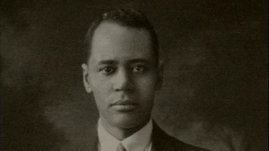Teachers' Domain - Digital Media for the Classroom and Professional Development
User: Preview

Source: The Rise and Fall of Jim Crow: "Don't Shout Too Soon"
Charles Hamilton Houston, former dean of Howard University’s law school and chief legal counsel for the NAACP, believed discrimination in education was symbolic of many forms of discriminations facing African Americans in society. This video shows how Houston documented the separate and unequal conditions existing for white and black students in the South and prepared the way for the precedent-setting Supreme Court case Brown v. Board of Education.
An accomplished lawyer who served as chief attorney for the National Association of Colored People (NAACP), Charles Hamilton Houston’s lasting legacy is the development of a legal strategy that eventually led the United States Supreme Court to declare segregation in American schools unconstitutional.
Born in Washington, D.C. where his father was a lawyer, Houston graduated as one of six valedictorians from Amherst College in Massachusetts in 1915. After teaching for two years at Howard University in Washington, D.C., he enlisted in the U.S. Army and was commissioned first lieutenant in a segregated training unit of the infantry. He was later commissioned as a second lieutenant in field artillery and served in France and Germany during World War I. Houston was outraged at the treatment of black soldiers accused of crimes who were unfairly sentenced to long terms, often without evidence to substantiate the charges against them. He became determined to change things. Following his discharge from the army in 1919, Houston enrolled at Harvard Law School, where he was the first black editor of the Harvard Law Review. After being admitted to the Washington, D.C. bar in 1924, he practiced law with his father. He served as vice-dean of Howard University Law School from 1929 to 1935, during which time he shaped the school into a significant institution, training almost a quarter of the nation's black law students. He focused on civil-rights law, a subject that was not part of the curriculum of America's law schools. Among his students were Thurgood Marshall, Oliver Hill, and Spottiswood Robinson, all of whom would play major roles in overturning segregation in the courts. From 1935 to 1939, Houston served as special counsel for the NAACP and became the architect of the legal challenge to Jim Crow. He felt that the weakest link in the chain of segregation was education, since black and white schools were unquestionably unequal in every Southern state. In Gaines v. Canada (1939), Houston argued before the U.S. Supreme Court that it was unconstitutional for Missouri to exclude blacks from the state's university law school when, under the "separate but equal" provision, no comparable facility for blacks existed within the state. The court agreed. In methodical fashion, Houston applied his belief that if the NAACP could build up enough smaller victories in the courts, there would be enough precedents established for the court to eventually declare all forms of segregation in education unconstitutional. Houston's efforts came to fruition only after his death in 1950, with the historic decision in Brown v. Board of Education (1954) decision. Segregation was prohibited in public schools, and would soon be declared unconstitutional in all its forms.NARRATION: One man – Charles Hamilton Houston – believed that not only could the NAACP do more, it had to take the lead. In 1935 he left his job as the dean of the prestigious law school at Howard University to become the NAACP's first full-time salaried legal counsel in 20 years.
PATRICIA SULLIVAN: Charles Hamilton Houston went to South Carolina with a movie camera and would film, county by county, the black school and the white school, and it was just this visual essay in inequality. But inequality doesn't even describe it. I mean just the…the awful conditions that young black children went to school under. I mean they had …had schoolhouses where there were cracks in the wall, they were crowded together on benches. And then the white school in the same county would have the brick structure, two stories, basketball court. I mean it was just so clearly unequal. And he would use that to show in the North, to kind of get support for the campaign, and really put a face on what segregation meant.
BRIAN STEVENSON: There were still people even in the NAACP who thought that black people simply had to improve their own worlds, and to make them sort of somehow better and more sustainable. Houston said it won't work that way. We have to basically integrate ourselves into all of the public goods and public resources that are around us, and until we do that, we're going to always be considered inferior.
VOICE OF CHARLES HAMILTON HOUSTON: "Discrimination in education is symbolic of all the more drastic discriminations which Negroes suffer in American life. And these apparent senseless discriminations in education against Negroes have a very definite objective on the part of the ruling whites to curve the young blacks and prepare them to accept an inferior position in American life without protest or struggle. The discriminations practiced against the Negro are no accident." Charles Houston.
NARRATION: Houston was convinced that the battle for civil rights had to be won in the schools, but would have to be fought in the courts.
 Loading Standards
Loading Standards